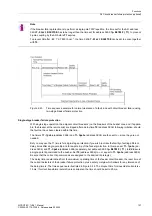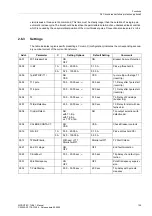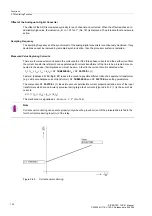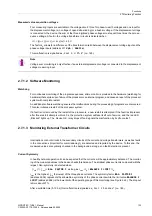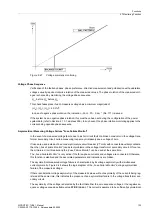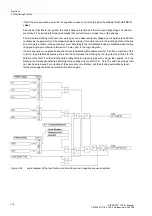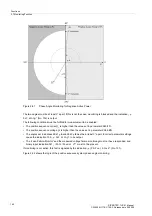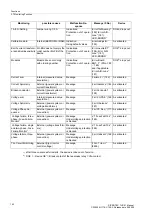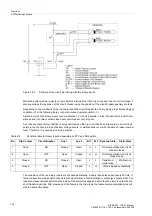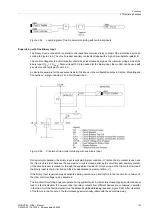
Functions
2.7 Monitoring Function
SIPROTEC, 7VK61, Manual
C53000-G1176-C159-3, Release date 05.2009
133
Measured value acquisition voltages
Four measuring inputs are available in the voltage circuit: three for phase-to-earth voltages and one input for
the displacement voltage (e-n voltage of open delta winding) or a busbar voltage. If the displacement voltage
is connected to the device, the sum of the three digitized phase voltages must equal three times the zero se-
quence voltage. A fault in the voltage transformer circuits is detected when
U
F
= |U
L1
+ U
L2
+ U
L3
+ k
U
·U
EN
| > 25 V.
The factor k
U
allows for a difference of the transformation ratio between the displacement voltage input and the
phase voltage inputs (address
211
Uph / Udelta
).
This malfunction is signalled as
„Fail
Σ
U Ph-E“
(no. 165).
Note
Voltage sum monitoring is only effective if an external displacement voltage is connected to the displacement
voltage measuring input.
2.7.1.2
Software Monitoring
Watchdog
For continuous monitoring of the program sequences, a time monitor is provided in the hardware (watchdog for
hardware) that expires upon failure of the processor or an internal program, and causes a reset of the processor
system with complete restart.
An additional software watchdog ensures that malfunctions during the processing of programs are discovered.
This also initiates a restart of the processor system.
If a fault is not removed by the restart of the processors, a new restart is attempted. If the fault is still present
after three restart attempts within 30 s, the protection system will take itself out of service, and the red LED
„Blocked“ lights up. The Device OK relay drops off and signals the malfunction by its „life contact“.
2.7.1.3
Monitoring External Transformer Circuits
Interruptions or short-circuits in the secondary circuits of the current and voltage transformers, as well as faults
in the connections (important for commissioning!), are detected and reported by the device. To this end, the
measured values are cyclically checked in the background as long as no fault detection is present.
Current Symmetry
In healthy network operation it can be expected that the currents will be approximately balanced. The monitor-
ing of the measured values in the device checks this balance. The smallest phase current is compared with the
largest. Non-symmetry is detected when
|
I
min
| / |
I
max
| <
BAL. FACTOR I
as long as
I
max
/
I
N
>
BALANCE I LIMIT
/
I
N
I
max
is the highest,
I
min
the lowest of the three phase currents. The symmetry factor
BAL. FACTOR I
(address
2905
) represents the allowable asymmetry of the phase currents while the limit value
BALANCE I
LIMIT
(address
2904
) is the lower limit of the operating range of this monitoring (see Figure 2-46). The dropout
ratio is about 97%.
After a settable time (5-100 s) this malfunction is signaled as
„Fail I balance“
(no. 163).
Summary of Contents for Siprotec 7VK61
Page 8: ...Preface SIPROTEC 7VK61 Manual C53000 G1176 C159 3 Release date 05 2009 8 ...
Page 14: ...Contents SIPROTEC 7VK61 Manual C53000 G1176 C159 3 Release date 05 2009 14 ...
Page 316: ...Literature SIPROTEC 7VK61 Manual C53000 G1176 C159 3 Release date 05 2009 316 ...
Page 328: ...Glossary SIPROTEC 7VK61 Manual C53000 G1176 C159 3 Release date 05 2009 328 ...









